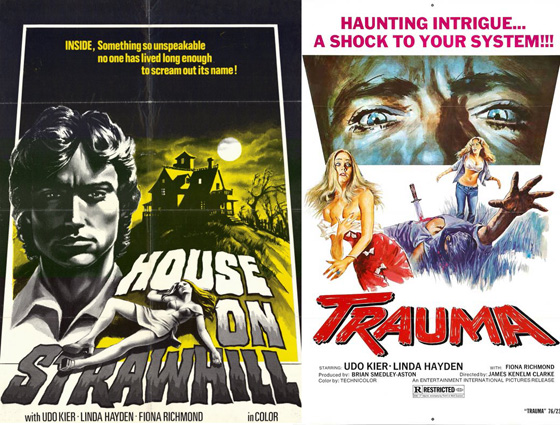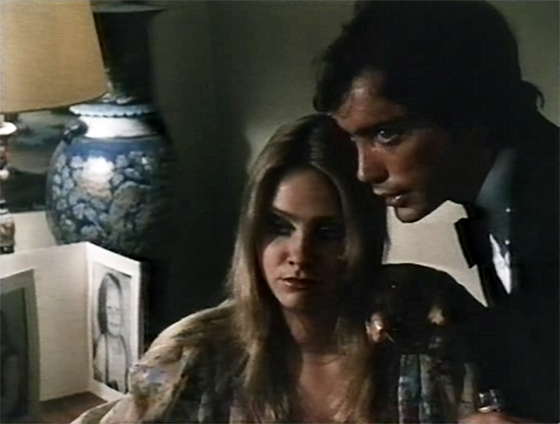 Like so many exploitation films of the 70’s, this one has multiple titles – it’s best known as Exposé (as it was originally released in its native Great Britain in 1976). In certain territories it went out as either Trauma or The House on Straw Hill, and I’m going with the latter title because that’s what appears on the print on the VHS tape I’m reviewing, released by New World Video in the mid-80’s. It’s also probably the most appropriate title for this atmospheric little thriller starring Udo Kier (Blood for Dracula) and Linda Hayden (The Blood on Satan’s Claw). Why am I reviewing a VHS tape (or, to be precise, a digital torrent of a VHS tape)? Because right now it’s the easiest way to view the full uncut version of the film: The House on Straw Hill made the infamous “video nasties” list compiled by the Department of Public Prosecutions in England to prevent explicit VHS tapes falling into the hands of children. After the Video Recordings Act of 1984, all “video nasties” were withdrawn from shelves, though many slipped back into availability after having the most offensive content removed, and then resubmitted to the British Board of Film Classification for review. Many of the nasties became eagerly-sought cult items as a result; and this was a list that included The Last House on the Left (1972), Flesh for Frankenstein (1973), The Toolbox Murders (1978), I Spit on Your Grave (1978), Cannibal Holocaust (1980), Inferno (1980), The Burning (1981), and The Evil Dead (1981). To include The House on Straw Hill in this mix seems bizarre, since the violence is not all that extreme, and the sexual content, though eyebrow-raising, is certainly no more graphic than what was flooding British cinemas in the 1970’s.
Like so many exploitation films of the 70’s, this one has multiple titles – it’s best known as Exposé (as it was originally released in its native Great Britain in 1976). In certain territories it went out as either Trauma or The House on Straw Hill, and I’m going with the latter title because that’s what appears on the print on the VHS tape I’m reviewing, released by New World Video in the mid-80’s. It’s also probably the most appropriate title for this atmospheric little thriller starring Udo Kier (Blood for Dracula) and Linda Hayden (The Blood on Satan’s Claw). Why am I reviewing a VHS tape (or, to be precise, a digital torrent of a VHS tape)? Because right now it’s the easiest way to view the full uncut version of the film: The House on Straw Hill made the infamous “video nasties” list compiled by the Department of Public Prosecutions in England to prevent explicit VHS tapes falling into the hands of children. After the Video Recordings Act of 1984, all “video nasties” were withdrawn from shelves, though many slipped back into availability after having the most offensive content removed, and then resubmitted to the British Board of Film Classification for review. Many of the nasties became eagerly-sought cult items as a result; and this was a list that included The Last House on the Left (1972), Flesh for Frankenstein (1973), The Toolbox Murders (1978), I Spit on Your Grave (1978), Cannibal Holocaust (1980), Inferno (1980), The Burning (1981), and The Evil Dead (1981). To include The House on Straw Hill in this mix seems bizarre, since the violence is not all that extreme, and the sexual content, though eyebrow-raising, is certainly no more graphic than what was flooding British cinemas in the 1970’s.
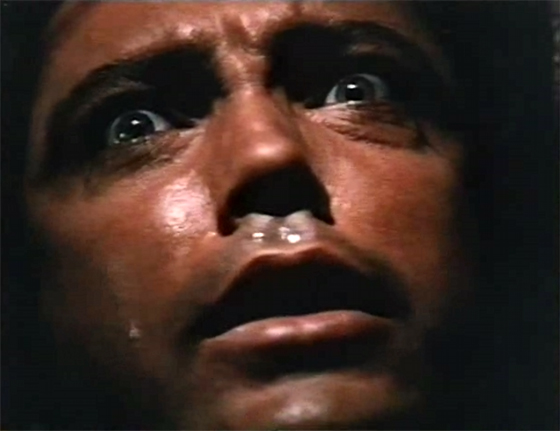
Bestselling author Paul Martin (Udo Kier), suffering from delirium.
Udo Kier – dubbed – plays Paul Martin, a bestselling author who, in the opening scenes, is having difficulty making love to his voluptuous girlfriend Suzanne (Fiona Richmond) because he’s suffering violent visions which may or may not be flashbacks. He sees a bloody limb in a bathtub, and blood-spattered hands, and blood splashed upon his manucript Straw Summer. He hallucinates that a stranger is approaching from beyond the window, and panics that the window isn’t locked. Later, he rides out to a train station to greet the typist he’s hired, a pretty girl with straw-colored hair named Linda (Linda Hayden). “Haven’t I met you somewhere before?” he asks her, but she denies it. Paul is being pressured to turn in his belated manuscript, and he hopes that he can overcome his lack of progress by resorting to dictation. On the drive back to his cottage on Straw Hill, they encounter two thugs at a gas station (one of whom, oddly, is wearing a tee-shirt which says “I am a Vampyre” – perhaps a nod to Kier’s previous role as Dracula for Paul Morrissey?). The men begin aggressively coming on to Linda, and Paul literally fights them off before escaping with her in the car. Once at Straw Hill, Linda settles in behind the typewriter, while Paul delivers his purple prose, pacing about the room and sipping liquor. He’s also given to self-important speeches: “You know this is the first time I’ve had to work to a deadline? The more successful you get, the more they want the next one, the more they’re prepared to pay. And the longer it takes you to write, the more impatient this whole lot of idiots become!” Linda coolly responds, “But you’ve only written two books.” “Yes, but it’s still the same,” Paul says, and drinks from his glass.
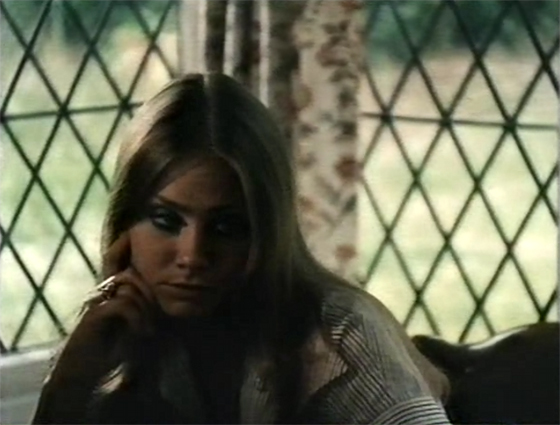
Linda (Linda Hayden), looking unimpressed during one of Paul's pompous speeches.
There’s something a little off about Linda, as you’d expect. When she retires to her room, she pulls a man’s portrait from her suitcase, sets it beside her on the bed, and masturbates. She asks the elderly housekeeper, Mrs. Aston (Patsy Smart), to leave, suggesting Paul doesn’t need any further distractions. Mrs. Aston refuses, and a few short scenes later – as the housekeeper explores the house late at night – someone cuts her throat with a knife, splattering blood on the framed photos hanging on the wall. Her body disappears, and Linda explains to Paul that Mrs. Aston has suddenly decided to leave. When Linda takes a walk in the fields of tall wheat that surround the cottage, she lies down and begins to masturbate. (There’s not a lot to do at Straw Hill, I guess.) She’s suddenly confronted by the two men from the gas station; while one points a shotgun at her, the other rapes her. (Though not too graphic, this is one of the scenes cut from the U.K. home video release.) Linda beckons to the man with the shotgun, drawing him closer, then swiftly disarms him and shoots them both. She arrives back at the cottage, seemingly unperturbed. Dictation resumes.
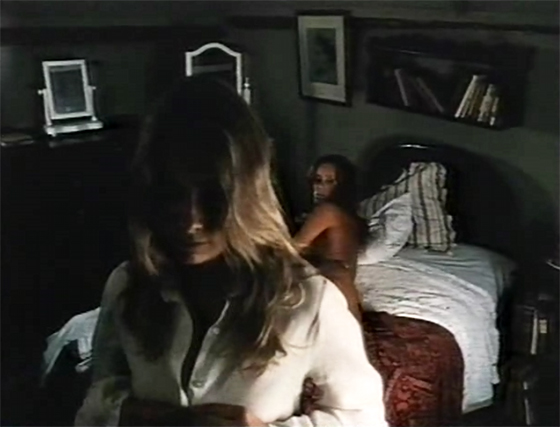
Linda efficiently seduces Paul's girlfriend Suzanne (Fiona Richmond).
Paul digs through her luggage when she’s away, discovers a photo of himself, and begins to suspect that she’s up to something. Nevertheless, he makes a drunken pass at her, which is scornfully rebuffed. Sexually frustrated, he calls up Suzanne again, but when she arrives, Linda sets out to seduce her immediately. When she walks in on their lovemaking with a cold, callous stare, Paul quickly dresses and chases her – he’s tricked into driving off and leaving the cottage, and like the efficient seductress/psychopath she is, Linda circles back and makes passionate love to Suzanne, finishing what Paul had started. Meanwhile, Paul accidentally crashes his speeding car into a creek, thus conveniently delaying his return. After Suzanne stumbles across Mrs. Aston’s body stashed in a closet, she’s stalked by an unseen killer, cornered in a bathroom, and swiftly butchered by a slashing knife. By the time Paul gets back, Suzanne is declared “asleep and not to be disturbed.” Dictation resumes. Only this time she begins to take control of the manuscript, forcing her own opinions, typing what she wants. This leads to – not exactly a twist, as was so common in suspense thrillers post-Psycho – but a logical plot revelation that satisfyingly strips the egomaniac Paul Martin down to the bone.
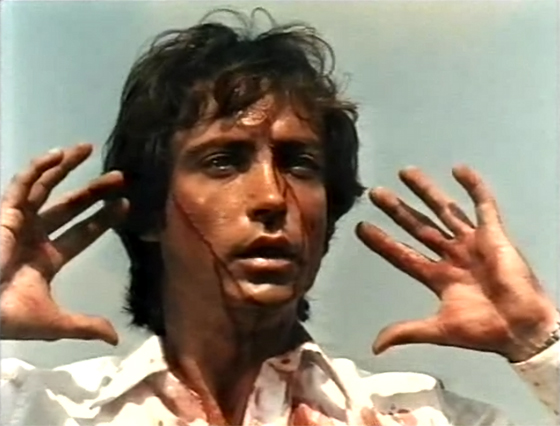
Paul is cornered, bloodied, and exposed.
Director James Kenelm Clarke had a brief and undistinguished career, but does fine work on The House on Straw Hill, making good use of the evocative space (particularly the swaying fields of wheat). Some punchy shots play up the story’s pulpy style, including close-ups of the manual typewriter firing its typebars like bullets, and the carriage leaps at the camera like a battering ram. The close-ups of slit throats and splattered blood borrow from the burgeoning giallo genre (Kier was soon to cameo in one of the key giallo films, Argento’s Suspiria). But of course it’s the erotic element, so over-the-top that it nearly becomes deranged, which is central to the suffocatingly lurid atmosphere. This is an “erotic thriller,” by subgenre, and would make a good double feature with other thrillers about British sexual frustration, such as Hammer’s Crescendo (1969), or Baby Love (1968), the Lolita-on-acid exploitation film which had introduced Straw Hill star Hayden, then just a teenager, to the country’s cinemas. (The film also reminded me of all those increasingly absurd 90’s erotic thrillers that followed in the wake of Basic Instinct‘s success.) The stunningly beautiful Hayden was a gifted actress whose career, unfortunately, was derailed along with so many other British actors’ when the country’s film industry began to dry up in the 70’s. The only sure-fire way to make a profitable low-budget film was to sell it with sex, and Hayden went where the money was, transitioning from two excellent and subversive horror films (Taste the Blood of Dracula and The Blood on Satan’s Claw) into Confessions of a Window Cleaner (1974) and the like, many with her real-life romantic interest Robin Askwith. (Hayden has a role in the remake of The House on Straw Hill/Exposé, 2010’s Stalker, which features as its protagonist a female writer named Paula Martin, played by Anna Brecon.) The tremendously popular sexpot Fiona Richmond was a columnist for Men Only magazine and a star of burlesque in London’s West End, and this was one of her first major roles, though I must say she’s not much of an actress. Udo Kier’s long and prolific career in genre films is well-known and needs no rehashing; he still makes several films a year, and recently played Pope Innocent VIII on the TV series Borgia. Here, he makes the most of his bulging eyes and fevered expressions. Make no mistake, The House on Straw Hill is not high art, but it’s very entertaining grindhouse.
